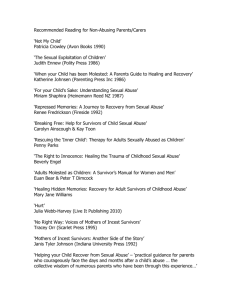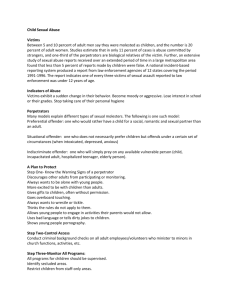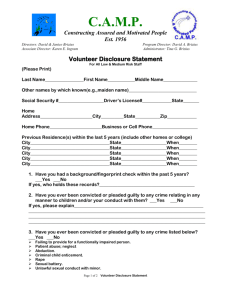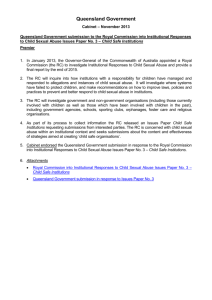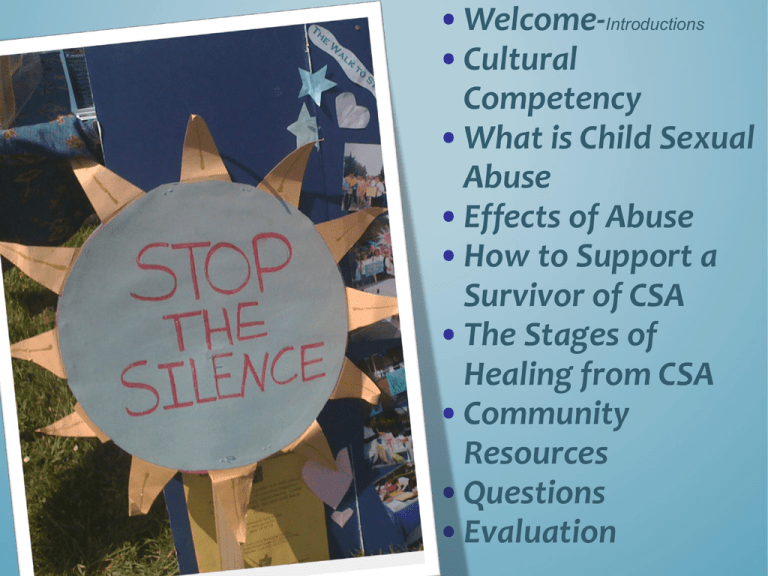
•Welcome-Introductions
•Cultural
Competency
•What is Child Sexual
Abuse
•Effects of Abuse
•How to Support a
Survivor of CSA
•The Stages of
Healing from CSA
•Community
Resources
•Questions
•Evaluation
GROUP RESPONSIBILITIES
•Take Care of Yourself
•Confidentiality
•Listen Respectfully
•Honor Time Limits
•Respect Differences
•Keep an Open Mind
Child Sexual Abuse Training
SURVIVORS
HEALING
CENTER
OUR SERVICES
• Intensive Therapy Groups
• Information and Referrals
• Outreach and Education
• Free Lending Library
• Art of Healing Event
• Walk To Stop the Silence Event
• Speaker Panels
• Volunteer Opportunities
Child Sexual Abuse Training
WHAT IS
CHILD
SEXUAL
ABUSE?
•1/4 girls and 1/6 boys are sexually assaulted before
they turn 18 (ACE Study)
•Only 3/10 rapes are reported to the police (FBI)
•Without support any people live with the shame of
sexual assault for their entire lives
Child Sexual Abuse Training
CHILD SEXUAL ABUSE (CSA)
Child sexual abuse includes a wide range of sexual
behaviors that take place between: a child and an older
person(adult) or between two children.
CSA occurs when full consent of involved parties is not possible due to
differences in size, power, age, developmental level, or authority.
•
•
•
•
•
•
Molestation
Rape
Penetration
Oral Copulation
Sodomy
Commercial Sexual Exploitation of Children
Child Sexual Abuse Training
CHILD SEXUAL ABUSE
•
•
•
•
•
Photographing the child for sexual purposes
Showing the child pornographic materials
Sexualized talk with the child
Exposing genital areas to the child for sexual gratification
"Peeping" in on child while dressing, showering, using the
restroom
• Masturbating in front of the child
• Making the child engage in:
o
o
o
o
oral sex
vaginal or anal intercourse
prostitution
sexual activities with animals
Child Sexual Abuse Training
EFFECTS OF
CHILD
SEXUAL
ABUSE
Effects of Child Sexual
Abuse
•
•
•
•
•
•
•
•
•
•
Low self-esteem
Depression
Anxiety
Isolation
Regressive behaviors
Dissociation
Nightmares
Flashbacks
Difficulty concentrating
Feeling unsafe
•
•
•
•
•
•
•
•
•
Promiscuity
Early pregnancy
Prostitution
Drug and alcohol abuse
Self-harm behaviors
(cutting, burning)
Eating disorders
Abstinence of sex
Interpersonal difficulties
(trouble at work or
home…)
Running Away
KEY TERMS AND EFFECTS
• Stress : non-specific response of the body to any
demand that overwhelms resources – positive and
negative stressors – getting married, changing jobs,
sex etc… Stress produces the activation of the
sympathetic nervous system
• Trauma : threat to one’s life or bodily integrity, hyperarousal of the ANS, not all traumatic events lead to
trauma.
• Traumatic stress : a normal reaction of the mind and
body to an overwhelming event that threatens life
and/or limb: your own, someone close to you, or that
you witness. Someone with traumatic stress may be
reacting to recent events, or event from childhood
• Post-traumatic Stress: traumatic stress that has not
been processed by the body
FIGHT, FLIGHT, FREEZE
During a traumatic event, the brain tells the nervous
system to prepare the body for a defensive action, such
as
FIGHT
or
FLIGHT
if those actions are not possible, the brain tells the
nervous system to FREEZE
These changes are normal responses to an abnormal
event. After the event is over, the nervous system will
usually return these body systems to a normal level of
functioning within a few hours, days or weeks.
ADVERSE CHILDHOOD
EXPERIENCE (ACE STUDY)
• What’s an Ace
Study?
• Collaboration
between Kaiser San
Diego and Center for
Disease Control
(CDC)
• 17,000 participants
Child Sexual Abuse Training
Depression:
Most say depression is a disease.
Many say depression is genetic.
Some say it is due to a chemical imbalance.
What if depression were not a disease,
but a normal response to
abnormal life experiences?
Major Findings:
2 out of 3 had at least one ACE
11% had five or more ACEs
People with 4 Ace’s or more were
7 times more likely to be alcoholics,
10 times more likely to have used street drugs,
12 times more likely to attempt suicide,
6 times more likely to be raped
4 times more likely to suffer from chronic depression
have health problems (heart disease, obesity),
STATISTICS
Survivors of
childhood sexual
abuse make up a
large proportion of
certain at-risk
populations
• 59% of females in prison
• 95% of teenage
prostitutes
• 60% of teen mothers
• 43% of adolescent
runaways
• 53% reported substance
abusers
• 60-80% of individuals in
substance abuse
facilities
SUPPORTING
A SURVIVOR
RISKS OF TRAUMA
THERAPY
• Risk of trauma becoming overwhelming
Overwhelm : when more memories are elicited into
consciousness – images, facts and/or bodily sensations,
than can be integrated at one time.
• Risk of therapy becoming associated with the trauma,
and the therapist with the perpetrator
• SAFETY – must first establish safety in therapy and the
client’s life before the trauma can be dealt with
Child Sexual Abuse Training
SAFETY
• Recognizing and naming the symptoms
• Developing support and coping strategies
• Have a concrete safety plan
• Develop trusting relationships
• Mobilizing social network
• Control of body: getting enough sleep, exercise,
food, regulation of symptoms and understanding
self-harm behavior
• Safety of environment: safe place to live, plan to
protect, transportation, financial resources
Child Sexual Abuse Training
EVALUATION AND
ASSESSMENT
Trauma I – client who has a single instance of trauma, stable
background and previously had safe coping mechanisms
Trauma II – client who experienced multiple traumas
II A – client has come from a stable background, can
distinguish the multiple traumas from one another
II B – client is unable to distinguish the traumas from
one another (“Complex PTSD” – J. Herman)
II B-R – someone who previously had safe
coping mechanisms, but has become overwhelmed by so
many traumas (i.e.: holocaust survivors )
II B- nR – someone who has never had safe
coping skills.
Child Sexual Abuse Training
RESOURCES IN TRAUMA THERAPY
• Slowing down / applying the brakes
• Resource building
• Body awareness
• Dual awareness
• Muscle training
• Boundaries
Child Sexual Abuse Training
HOW TO RECOGNIZE
OVERWHELM
• Eyes become glazed over
• Unable to look at you
• Pale face
• Short, quick breathing
• Dilated pupils
Child Sexual Abuse Training
HEALING IS
POSSIBLE….
WITH HELP
Healing is
Listening to my intuition, my “inner knowing” and acting accordingly.
Not second guessing myself.
Having energy to take care of my home and life stuff.
When I can help others and still have time and energy for my needs.
Looking at the past with compassion and gentleness.
Not having flashbacks or memories.
Not having flashbacks or memories (control my life).
When memories are there but not in charge.
Healing is
Acknowledging the past, accepting the future and living in the moment.
Embracing fun and pleasure without guilt or fear.
Not isolating from people.
Connecting to people.
Living in the present.
Building trust in myself
Finding support, and learning how not to be so alone.
An uncharted journey.
10 FOUNDATIONS
1. Safety
2. Develop a good relationship
3. Slow down
4. Identify and build on current resources
5. Regard defenses as resources
6. Trauma is a pressure cooker
7. Adapt the therapy to the client
8. Have a broad theory of knowledge
9. Recognize your client is an individual
10. Be prepared just to talk
Child Sexual Abuse Training
It is possible to move away from a vast,
unbearable pain by delving into it deeper and
deeper […]. You can look at all the parts of a
terrible thing until you can see that they are
assemblies of smaller parts, all of which you
can name and some of which you can heal or
alter, and finally the terror that seemed
unbearable becomes manageable.
Barbara Kingsolver
RESOURCES
• Child Protective Services 454-4222
• Monterey Rape Crisis Center 663-5900
• Parent Center 426-7322 / 724-2879
• Family Services 423-9444
• National Child Abuse Hotline 1-800-422-4453
• Survivors Healing Center 423-7601
• Survivors of Incest Anonymous 477-4165
• Youth Services 435-0771/ 728-2226
• Victim Services 454-2010/ 763-8166
• Women’s Crisis Support Crisis Line 685-3737
Child Sexual Abuse Training
Good books to read on this topic:
Ellen Bass and Laura Davis: The Courage to Heal
Staci Haynes: The Survivors Guide to Sex
Judith Herman: Trauma and Recovery
Babette Rotschild: The Body Remembers
Peter Levine: Waking the Tiger
Karen Adams and Jennifer Fay: No more secrets:
Protecting your child from child sexual assault
Eliana Gil: Helping Abused and Trumatized Children
Eliana Gil: Someone in my Family has Molested Children
Karen Johnson: The Troublke With Secrets
IN CLOSING…
• Closing Statements- Is there any
Information you want to share with the group
regarding this training? Any comments in
general?
• Any Questions?
• Evaluations. Thank you!
Child Sexual Abuse Training
A WELCOMING PLACE FOR SURVIVORS OF
CHILD SEXUAL ABUSE AND THEIR SUPPORTERS
104 Walnut Avenue Suite 201
Santa Cruz, CA 95060
Phone: (831) 423-7601
Email: programsfsa@gmail.com
Child Sexual Abuse Training


